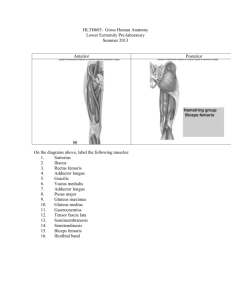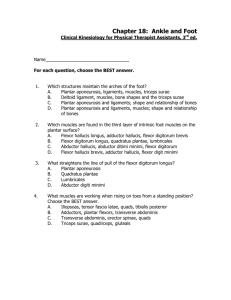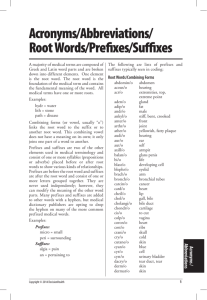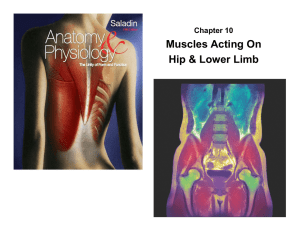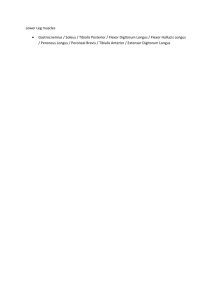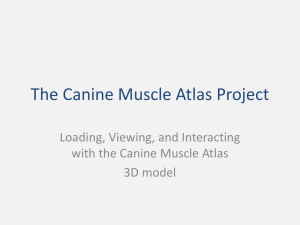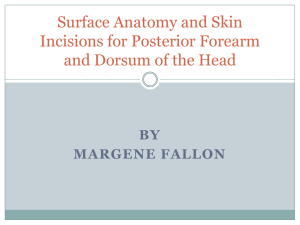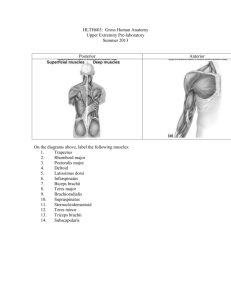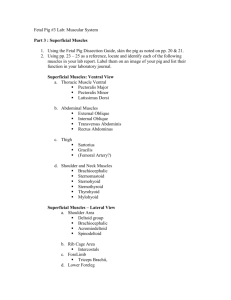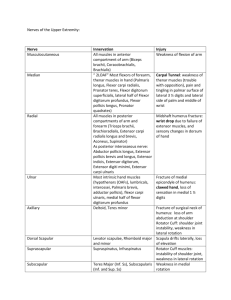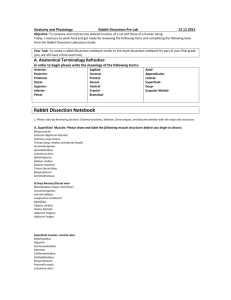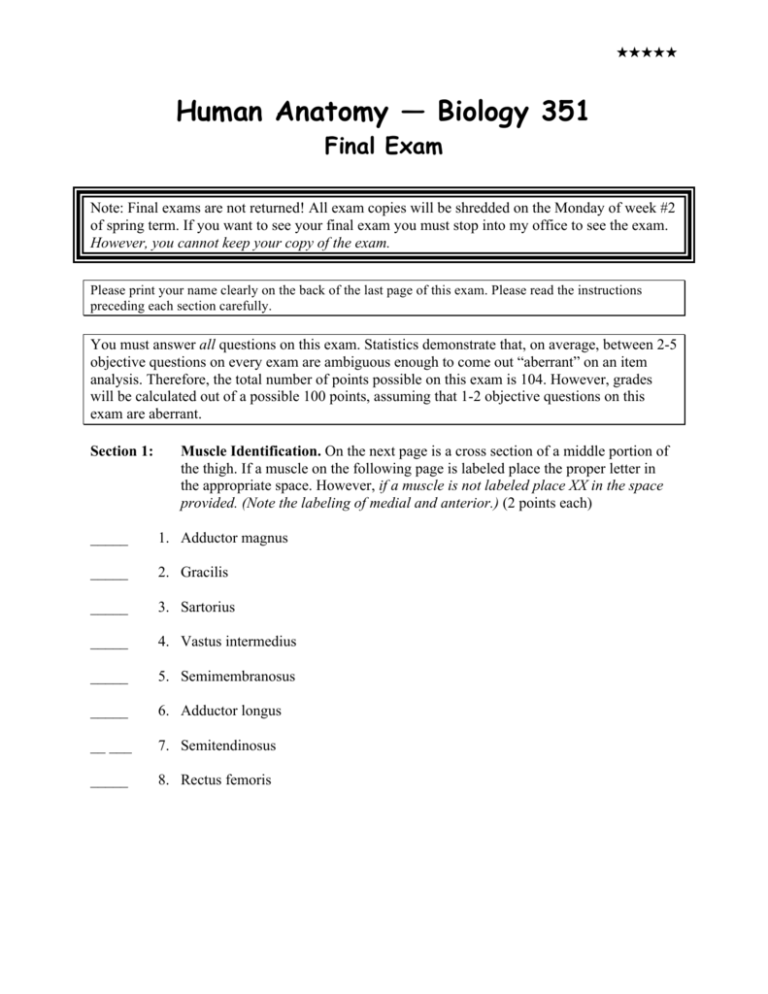
★★★★★
Human Anatomy — Biology 351
Final Exam
Note: Final exams are not returned! All exam copies will be shredded on the Monday of week #2
of spring term. If you want to see your final exam you must stop into my office to see the exam.
However, you cannot keep your copy of the exam.
Please print your name clearly on the back of the last page of this exam. Please read the instructions
preceding each section carefully.
You must answer all questions on this exam. Statistics demonstrate that, on average, between 2-5
objective questions on every exam are ambiguous enough to come out “aberrant” on an item
analysis. Therefore, the total number of points possible on this exam is 104. However, grades
will be calculated out of a possible 100 points, assuming that 1-2 objective questions on this
exam are aberrant.
Section 1:
Muscle Identification. On the next page is a cross section of a middle portion of
the thigh. If a muscle on the following page is labeled place the proper letter in
the appropriate space. However, if a muscle is not labeled place XX in the space
provided. (Note the labeling of medial and anterior.) (2 points each)
_____
1. Adductor magnus
_____
2. Gracilis
_____
3. Sartorius
_____
4. Vastus intermedius
_____
5. Semimembranosus
_____
6. Adductor longus
__ ___
7. Semitendinosus
_____
8. Rectus femoris
Plate Number
475B
Thigh
Middle Cross Section
Copyright © 1995 Ciba-Geigy Corporation All rights reserved.
★★★★★
Section 2:
_____
Muscle Identification. On the next page is a cross section of the leg. If a muscle
on the following page is labeled place the proper number in the appropriate space.
However, if a muscle is not labeled place XX in the space provided. Note that you
should be able to determine anterior, posterior, medial and lateral are by the
bones of the leg, which you should know.) (2 points each)
9. Tibialis anterior
_____
10. Flexor hallicus longus
_____
11. Fibularis longus
_____
12. Fibularis brevis
_____
13. Tibialis posterior
_____
14. Extensor hallicus longus
_____
15. Flexor digitorum longus
Plate Number
491B
Leg
Cross Section just above Middle of Left Leg
Copyright © 1995 Ciba-Geigy Corporation All rights reserved.
★★★★★
Section 3:
Agonist-antagonist muscles. Answer the following questions by placing a (+) in
the space provided if the statement is true; place a (O) in the space provided if the
statement is false. (2 points each)
_____
16. The gluteus medius is an antagonist to at least one action of the gluteus maximus.
_____
17. The gluteus minimus is an antagonist to at least one action of the gluteus
maximus.
_____
18. The gluteus medius is an antagonist to at least one action of the tensor fascia latae.
_____
19. The gluteus maximus is an antagonist to at least one action of the tensor fascia
latae.
_____
20. The gracilis is an antagonist to at least one action of the adductor longus.
_____
21. The gracilis is an antagonist to at least two of the actions of the adductor magnus.
_____
22. The gracilis is an antagonist to at least one of the actions of the adductor magnus.
_____
23. The long head of the biceps femoris is an antagonist to at least one action of the
adductor longus.
_____
24. The fibularis longus is an antagonist to all of the actions of the tibialis anterior.
_____
25. The extensor hallicus longus is an antagonist to at least one of the actions of the
fibularis longus.
Section 4:
_____
Muscles of the gluteal region, anterior and adductor groups of the thigh.
Place the most correct letter in the space provided. (2 points each)
26. Which of the following muscles matches the description below?
• Originates on the anterior, inferior iliac spine and the rim of the
acetabulum
• Inserts onto the tibial tuberosity via the patellar ligament and tendon
• Flexes the thigh and extends the leg
a. rectus femoris
b. vastus lateralis
c. vastus medialis
d. sartorius
e. adductor longus
f. adductor magnus
g. iliopsoas
h. gracilis
★★★★★
_____
27. Which of the following muscles matches the description below?
• Originates from the anterior superior iliac spine
• Inserts onto the tibia
• Innervated by the femoral nerve
• Flexes, abducts, and laterally rotates the thigh; flexes the leg
a. rectus femoris
b. vastus lateralis
c. vastus medialis
d. sartorius
e. adductor longus
f. adductor magnus
g. iliopsoas
h. gracilis
_____
28. Which of the muscles in the list below flexes and medially rotates the leg and
adducts and medially rotates the thigh?
a. rectus femoris
b. vastus lateralis
c. vastus medialis
d. sartorius
e. adductor longus
f. adductor magnus
g. iliopsoas
h. gracilis
_____
29. Which of the muscles listed below adducts, flexes, extends and medially rotates
the thigh?
a. rectus femoris
b. vastus lateralis
c. vastus medialis
d. sartorius
e. adductor longus
f. adductor magnus
g. iliopsoas
h. gracilis
_____
30. Which of the following is not an attachment (either origin or insertion) of the
adductor magnus?
a. linea aspera of the femur
b. ischial tuberosity
c. inferior pubic ramus
d. pubic tubercle
e. adductor tubercle of the femur
★★★★★
_____
31. Which of the following is not an attachment (either origin or insertion) of the
gluteus maximus?
a. gluteal tuberosity of the femur
b. iliotibial tract
c. thoracolumbar fascia
d. coccygeal vertebrae
e. lumbar vertebrae
h. iliac crest
i. sacrum
_____
32. Which of the following muscles matches the description below?
• Origin on the iliac crest and the anterior superior iliac spine
• Medially rotates and possibly abducts the thigh
• Innervated by the superior gluteal nerve
a. gluteus maximus
b. gluteus medius
c. gluteus minimus
d. tensor fascia latae
Section 5:
Posterior muscles (hamstrings) of the thigh. Answer the following questions by
placing a (+) in the space provided if the statement is true; place a (O) in the space
provided if the statement is false. (2 points each)
_____
33. Both heads of the biceps femoris cross both the hip and knee joints.
_____
34. The short head of the biceps femoris originates from the adductor tubercle of the
femur.
_____
35. The long head of the biceps femoris is innervated by the common fibular nerve,
while the short head is innervated by the tibial portion of the sciatic nerve.
_____
36. All of the hamstrings have at least one of their origins on ischial tuberosity.
_____
37. Both the biceps femoris and the semitendinosus insert onto both the tibia and
fibula.
★★★★★
Section 6:
Muscles of the leg. Answer the following questions by placing the most
appropriate letter in the space provided. (2 points each)
_____
38. An origin on the tibia, insertion onto the 1st metatarsal and medial cuneiform,
innervation by the deep fibular nerve, and actions of dorsiflexion and inversion of
the foot describes the
a. tibialis anterior
b. extensor hallicus longus
c. extensor digitorum
d. fibularis longus
e. fibularis brevis
f. gastrocnemius
h. soleus
k. tibialis posterior
l. plantaris
m. popliteus
n. flexor digitorum
o. flexor hallicus longus
_____
39. Which of the following muscles originates from the tibia and fibula and has
dorsiflexion of the foot as at least one of its actions?
a. tibialis anterior
b. extensor hallicus longus
c. extensor digitorum
d. fibularis longus
e. fibularis brevis
f. gastrocnemius
h. soleus
k. tibialis posterior
l. plantaris
m. popliteus
n. flexor digitorum
o. flexor hallicus longus
★★★★★
_____
40. Which of the following muscles originates only from the fibula and inserts onto
one or more bones on the sole of the foot?
a. tibialis anterior
b. extensor hallicus longus
c. extensor digitorum
d. fibularis longus
e. fibularis brevis
f. gastrocnemius
h. soleus
k. tibialis posterior
l. plantaris
m. popliteus
n. flexor digitorum
o. flexor hallicus longus
_____
41. Which of the following muscles originates from the supracondylar ridge of the
femur?
a. tibialis anterior
b. extensor hallicus longus
c. extensor digitorum
d. fibularis longus
e. fibularis brevis
f. gastrocnemius
h. soleus
k. tibialis posterior
l. plantaris
m. popliteus
n. flexor digitorum
o. flexor hallicus longus
_____
42. Which of the following muscles originates from the tibia, fibula and interosseous
membrane?
a. tibialis anterior
b. extensor hallicus longus
c. extensor digitorum
d. fibularis longus
e. fibularis brevis
f. gastrocnemius
h. soleus
k. tibialis posterior
l. plantaris
m. popliteus
n. flexor digitorum
o. flexor hallicus longus
★★★★★
_____
43. Which of the following is not an attachment (either origin or insertion) of the
tibialis posterior?
a. tibia
b. fibula
c. interosseous membrane
d. navicular
e. cuboid
f. all three cuneiforms
g. metatarsals 2, 3 and 4
h. talus
Section 7:
Define the following terms in the space provided. (If you looked at either of the
practice tests this section won’t be a surprise.) (2 points each)
44.
trochanter
45.
tubercle
46.
condyle
47.
epicondyle
48.
plantar
49.
inversion
50.
eversion
51.
pes
52.
genu

